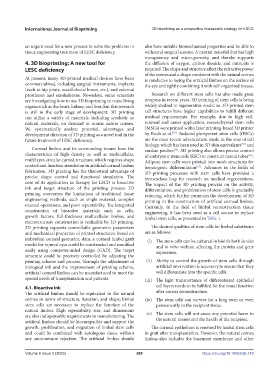Page 297 - IJB-9-3
P. 297
International Journal of Bioprinting 3D bioprinting as a prospective therapeutic strategy for LSCD
an urgent need for a new process to solve the problems in also have suitable biomechanical properties and be able to
tissue engineering treatment of LESC deficiency. withstand surgical sutures. A neutral material that has high
transparency and micro-porosity, and thereby supports
4. 3D bioprinting: A new tool for the diffusion of oxygen, carbon dioxide, and nutrients is
LESC deficiency required. The shape and structure affect the refractive power
of the cornea and a shape consistent with the natural cornea
At present, many 3D-printed medical devices have been is conducive to laying the artificial limbus on the surface of
commercialized, including surgical instruments, implants the eye and tightly combining it with self-organized tissues.
(such as hip joints, maxillofacial bones, etc.), and external
prostheses and exoskeletons. Nowadays, some scientists Research on different stem cells has also made great
are investigating how to use 3D bioprinting to make living progress in recent years. 3D printing of stem cells is being
organs such as the heart, kidney, and liver, but this research widely studied in regenerative medicine. 3D-printed stem
is still in the early stage of development. 3D printing cell structures have higher capabilities to fulfill different
can utilize a variety of materials, including synthetic or medical requirements. For example, due to high self-
natural materials, on demand to mimic nature cornea. renewal and easier application, mesenchymal stem cells
We systematically analyze potential, advantages and (MSCs) were printed with a laser printing-based 3D printer
[53]
development direction of 3D printing as a novel tool in the by Koch et al. . Induced pluripotent stem cells (iPSCs)
future treatment of LESC deficiency. are the most recent advancement made in the area of cell
biology, which has been used in 3D skin equivalents and
[54]
Corneal limbus and its surrounding tissues have the cardiac patches . 3D printing also allows precise control
[55]
characteristics of high density as well as multicellular, of embryonic stem cells (ESC) to construct neural tubes .
[56]
multilayer, circular curved structure, which requires shape Adipose stem cells were printed into mesh structures for
control and function simulation in artificial corneal limbus hepatogenic differentiation . Advances in the fields of
[57]
fabrication. 3D printing has the theoretical advantage of 3D printing processes with stem cells have provided a
precise shape control and functional simulation. The tremendous leap for research on medical regenerations.
core of its application in therapy for LSCD is bioactive The impact of the 3D printing process on the activity,
ink and target structure of the printing process: 3D differentiation, and proliferation of stem cells is gradually
printing overcomes the limitations of traditional tissue reducing, which further promotes the development of 3D
engineering methods, such as single material, complex printing in the construction of artificial corneal limbus.
manual operations, and poor repeatability. The integrated Currently, in the field of limbal reconstruction tissue
construction of bioactive materials such as cells, engineering, it has been used as a cell source to replace
growth factors, full-thickness multicellular limbus, and limbal stem cells, as presented in Table 1.
microstructure construction is realizable by 3D printing.
3D printing supports controllable geometric parameters The desired qualities of stem cells for limbal substitutes
and mechanical properties of printed structures. Based on are as follows:
individual corneal geometric data, a corneal limbal graft (i) The stem cells can be cultured in bioink both in vivo
model for injured eyes could be constructed and modified and in vitro without affecting the protein and gene
easily using computer-aided design (CAD). The target expression.
structure could be precisely controlled by adjusting the
printing scheme and process. Through the adjustment of (ii) Ability to control the growth of stem cells through
biological ink and the improvement of printing scheme, artificial intervention is necessary to ensure that they
artificial corneal limbus can be manufactured to meet the will differentiate into the specific cells.
special needs of transplantation and patients. (iii) The light transmittance of differentiated epithelial
4.1. Bioactive ink cell layers needs to be fulfilled for the visual function
The artificial limbus should be equivalent to the natural after cornea reconstruction.
cornea in terms of structure, function, and shape; limbal (iv) The stem cells can survive for a long term or even
stem cells are necessary to replace the function of the permanently in the recipient tissue.
natural limbus. High repeatability, size, and dimensions
are also indispensable requirements in manufacturing. The (v) The stem cells will not cause any potential harm to
artificial limbus should be biocompatible and support the the natural tissues and the health of the recipient.
growth, proliferation, and migration of limbal stem cells The corneal epithelium is renewed by limbal stem cells
and could be combined with autologous tissue without in graft after transplantation. However, the natural cornea
any autoimmune rejection. The artificial limbus should limbus also includes the basement membrane and other
Volume 9 Issue 3 (2023) 289 https://doi.org/10.18063/ijb.710

